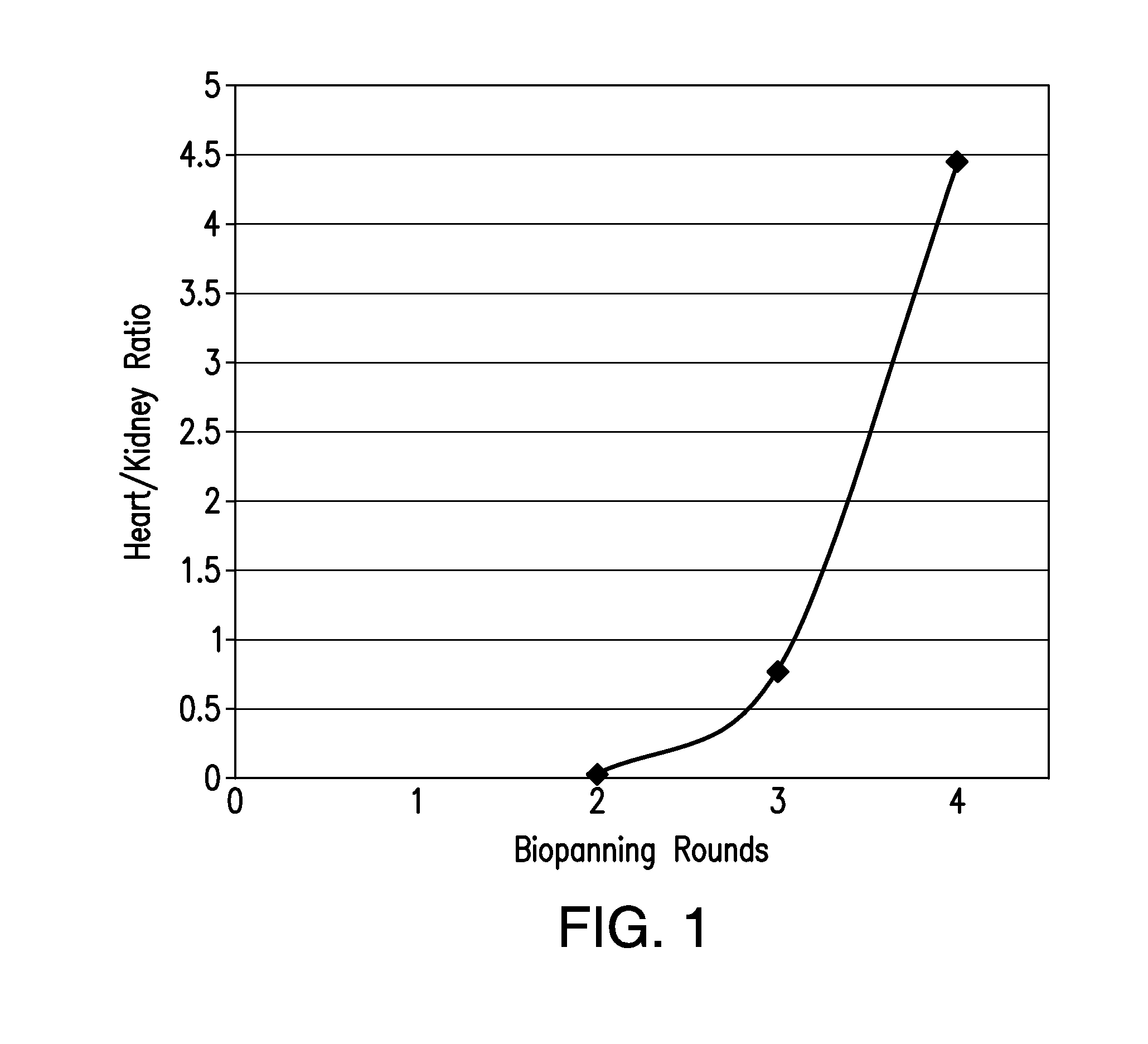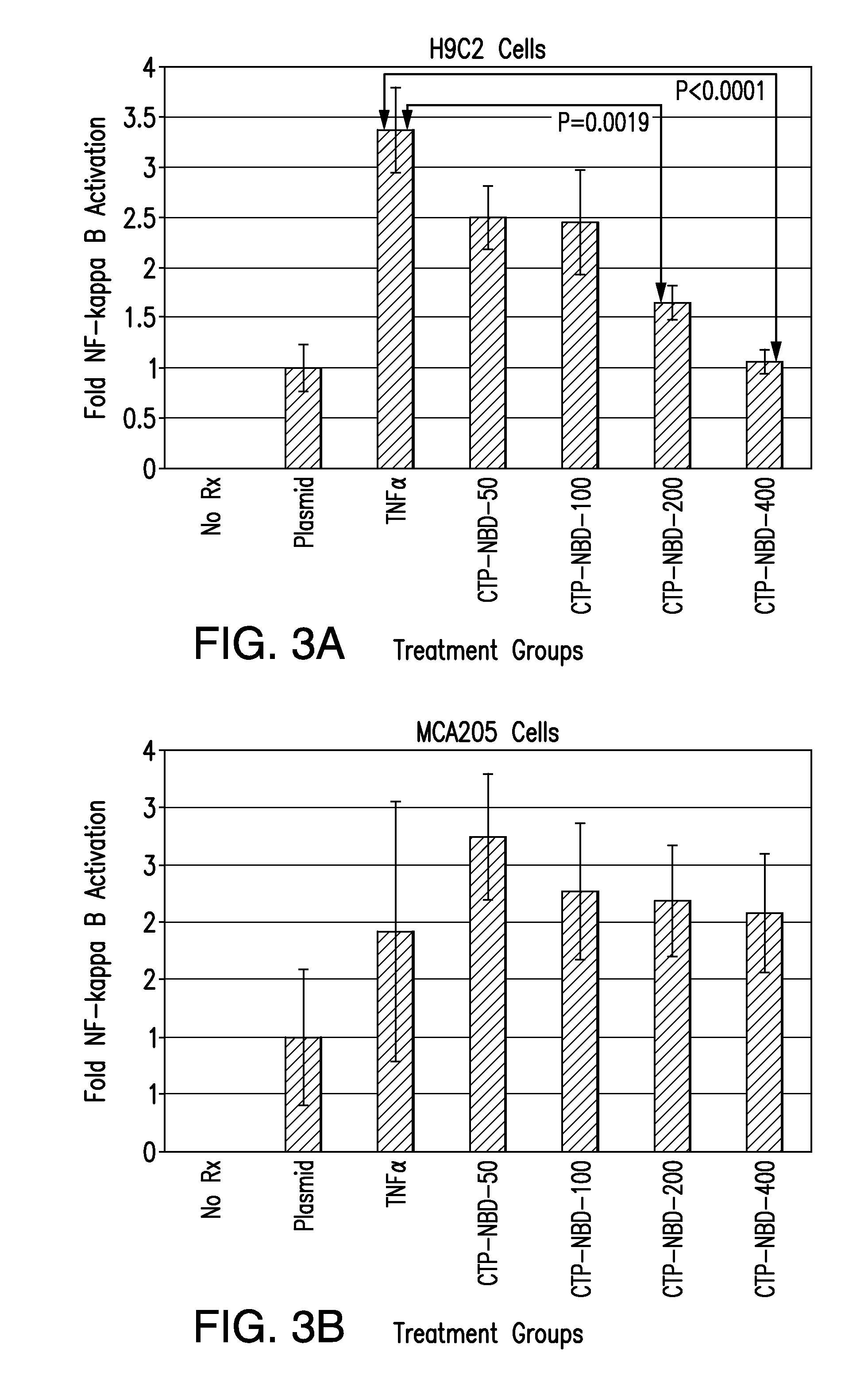Cardiac-Specific Protein Targeting Domain
a technology of specific protein and targeting domain, which is applied in the direction of peptides, drug compositions, metabolic disorders, etc., can solve the problems of reducing morbidity and mortality, affecting the development of these approaches, and becoming an increasingly significant problem
- Summary
- Abstract
- Description
- Claims
- Application Information
AI Technical Summary
Problems solved by technology
Method used
Image
Examples
example 1
6. EXAMPLE 1
6.1 Materials and Methods
[0087]Phage Display.
[0088]A combined approach of in vitro and in vivo screening of a phage peptide display library for cardiomyocyte-specific transduction peptides was utilized. Cardiomyoblasts, H9C2 cells (ATCC, CRL-1446), were incubated with 10 (161011 pfu) of a 12-mer M13 phage peptide display library (NEB, E8110S), for 6 hours at 37° C., 5% CO2. Cells were then washed extensively, trypsinized and lysed by a single freeze-thaw cycle. Recovered phage was tittered and amplified. The post-amplified phage was again tittered and administered intravenously by retro-orbital injection at a dose of 3.561011, to a female Balb / c mouse. The mice were pre-treated with intra-peritoneal injection of Chloroquine (20 mg / Kg) 24 hours prior to and on the day of the phage injection, in order to minimize intra-lysosomal destruction of internalized phage and increase the chances of recovering internalized phage. The phage was allowed to circulate for 24 hours, afte...
example 2
7. EXAMPLE 2
Viability Studies
[0109]Following the inhibition of NF-κB activation studies, we performed cell viability studies to assess changes related to peptide treatment. The experiment was repeated with H9C2 cells being doubly-transfected and pre-treated with CTP-NBD in increasing concentrations, followed by TNFα (10 ng / ml) challenge for 3 hours. After this time period, the media was aspirated and replaced with MTT assay media to assess for cell viability. As shown in FIG. 9, inhibition of NF-κB with CTP-NBD led to decrease in cell viability in a CTP-NBD dose-dependent fashion. All treatment groups were done in quadruplicate. Error bars represent 1 standard deviation (SD). These results are consistent with reports in the literature that NF-κB inhibition increases apoptosis in H9C2 cells challenged with TNFα (16), and clearly demonstrate a biological effect of the NBD peptide that is consistent with internalization of the peptide via CTP. This decrease in cell viability did not oc...
example 3
8. EXAMPLE 3
In Vivo Studies
[0110]To demonstrate cell specificity of the CTP peptide in vivo, we undertook a second set of experiments. Balb / C, female mice were anesthetized with intra-peritoneal Avertin (2.5%, 15 μl / gm of body weight), intubated with a 22 G cannula using direct laryngoscopy and visualization of the vocal chords, and placed on a rodent ventilator (Harvard apparatus). The chest cavity was entered using a left, lateral ternotomy approach, and an anterior infarct produced by placing a suture through the anterior wall, 2 mm inferior to the lowest dip of the left atrial appendage to blindly ligate the left anterior artery. Infarct was confirmed by the resulting pallor of the anterior wall and apex as well as wall motion abnormality produced in the region. The chest wall was closed in two layers, and the animal placed on a heating pad until awake. One week post-infarct, mice were re-anesthetized and injected intravenously with CTP-biotin-Streptavidin-Alexa488 (SA488) compl...
PUM
| Property | Measurement | Unit |
|---|---|---|
| Length | aaaaa | aaaaa |
| Composition | aaaaa | aaaaa |
Abstract
Description
Claims
Application Information
 Login to View More
Login to View More - R&D
- Intellectual Property
- Life Sciences
- Materials
- Tech Scout
- Unparalleled Data Quality
- Higher Quality Content
- 60% Fewer Hallucinations
Browse by: Latest US Patents, China's latest patents, Technical Efficacy Thesaurus, Application Domain, Technology Topic, Popular Technical Reports.
© 2025 PatSnap. All rights reserved.Legal|Privacy policy|Modern Slavery Act Transparency Statement|Sitemap|About US| Contact US: help@patsnap.com



